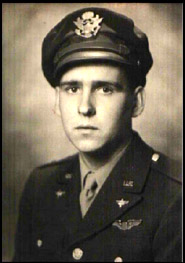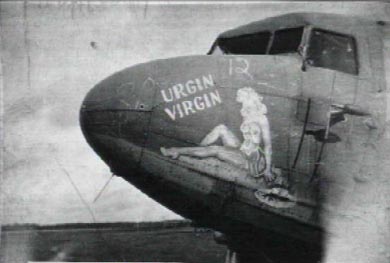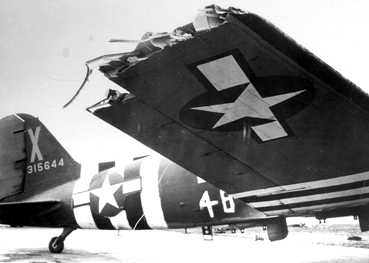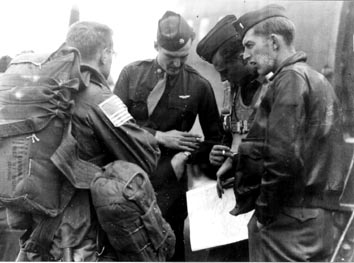A Profile In Courage-Adventures of C-47 Pilot Jess Harrison 77th TCS
 The "Urgin Virgin", a plane of the 435th TCG, was piloted by 24 year old Jess Harrison, carrying G/501 men to Normandy. Jess says the entire 77th Squadron under Col. Osmer, had received lots of blind flying training (instrument only) before D-Day. He cannot speak for the other two squadrons in the 435th group. He also says that the 77th stayed in formation when entering the cloudbanks at approximately 650 feet altitude over Normandy.
The "Urgin Virgin", a plane of the 435th TCG, was piloted by 24 year old Jess Harrison, carrying G/501 men to Normandy. Jess says the entire 77th Squadron under Col. Osmer, had received lots of blind flying training (instrument only) before D-Day. He cannot speak for the other two squadrons in the 435th group. He also says that the 77th stayed in formation when entering the cloudbanks at approximately 650 feet altitude over Normandy.
Jess was one of those pilots who missed the DZ on the first pass, but who courageously turned around 180 degrees to drop his passengers. Here's how it happened.
After emerging from the infamous cloudbanks on the west side of the Cotentin peninsula, Jess and the other planes in his 'V' encountered heavy flak near Picauville. Two planes near the 'Urgin Virgin' were hard hit. One exploded in midair,with all aboard killed. The other caught fire, drifted down and crashed with all but 3 of the original occupants still aboard.
Seeing this, Harrison dropped down to treetop level to foil the
German gunners, but he soon arrived at the east coast and realized he had overshot the DZ. Confering with Lt Norman Barker, the jumpmaster, they decided to turn around and make another pass.
Jess asked the LT how high he had to be for the parachutes to deploy. Barker guesstimated about 350 ft. When Harrison was reapproaching the DZ ('C') he climbed to about 400 feet, turned on the Green Light right over the DZ, and checked his airspeed indicator. He says he was flying at 135-40 m.p.h., when he gave the Green Light. The drop was right on target, although one paratrooper was struck by ground fire and killed as he exited the door. Another 501 trooper, Don Castona, had a bullet cut the heel of his boot, travel up through the calf of his pant leg, and exit without wounding him, as he floated down.
Jess made another 180 degree turn and headed east again, dropping back down to treetop level. As the 'Urgin Virgin' went out over the Channel, a large dark shape suddenly loomed up directly in its path. Harrison stood the plane on its tail just in time to avoid a collision with the Battleship Texas. The Navy had reluctantly agreed to withhold fire on all aircraft flying during the time of the T.C.drops, "because of the importance attached to the Airborne missions". He resumed deck flying the rest of the way across to England. After landing, he counted 67 holes in his plane.
 On 17 September, 1944, The 'Urgin Virgin' flew a stick of 101st paratroopers to DZ 'C' near Son, Holland, with Jess Harrison again at the controls. On 18 September, this plane towed a glider to Holland without incident. But on 19 September, Harrison towed another glider to the Netherlands, this time using a new plane. The doors of the 'Virgin' wouldn't close due to stress from glider towing. On this mission, the new plane was lost, and Jess Harrison became a hero.
On 17 September, 1944, The 'Urgin Virgin' flew a stick of 101st paratroopers to DZ 'C' near Son, Holland, with Jess Harrison again at the controls. On 18 September, this plane towed a glider to Holland without incident. But on 19 September, Harrison towed another glider to the Netherlands, this time using a new plane. The doors of the 'Virgin' wouldn't close due to stress from glider towing. On this mission, the new plane was lost, and Jess Harrison became a hero.
Hit by machinegun tracers a few miles short of the LZ, Harrison's crew bailed out when the fuselage of the plane caught fire, and the C-47 began losing altitude. Despite the smoke and flames, Jess noticed that the glider pilot he was towing still hadn't released from the tow rope. "If he has the guts to hang-in there, I'll stay at my controls", Jess decided. They flew on, still losing altitude, but reached the designated release point, above the Landing Zone. Releasing too soon would've landed the glider and its occupants in German territory, most likely resulting in their death or capture.
After the glider was released, Jess left the controls and went to the radio operator's table to find a bail-out chute. In the smoke, he managed to snap on the right side, but was unable to fasten the left side. He made his way back to the cabin and finished securing the parachute. Glancing at the altimeter, he saw that the plane was down to 300 feet and still descending.
Now, he had to move briskly toward the tail, through a solid wall of flame, to reach the exit door. He made his exit, pulled the ripcord handle, and heard his plane go-in. A second or two later, he hit the ground. Badly burned on the face and hands, Jess Harrison's war was over. He would spend many months in seven different hospitals, receiving skin grafts to his face, in a slow, painful recovery period.
The C-47 was destroyed, but Jess Harrison received the Silver Star for staying at the controls of his burning plane, to deliver the glider to the LZ. This story reminds me of what 506th trooper Don Burgett wrote in his book 'Currahee':
"We've got the greatest Air Corps in the world, bar none...I have witnessed pilots holding their burning planes on course, while the troopers cleared out, then die in the flaming wreckage."
Postscript to the Virgin. After Jess was WIA, his radio operator and flight engineer continued to fly in the 'Urgin Virgin'. At one point, the flight engineeer was forced to paint the word 'Censored' over the word 'Virgin' on the nose art. With a new pilot and co-pilot, the U.V. went on a resupply mission over France, lost bearings in the fog, and crashed into the side of a mountain, killing all aboard. (The usual crew chief was not aboard, as he had swapped places with with another who needed flight time to get his flight pay.)
On 6 June, 2000, three paratroopers who had jumped from Harrison's plane on D-Day, met for the first time since Normandy in Baltimore, MD, to celebrate D-Day plus 56 years. Jumpmaster John Urbank, Raymond Geddes and Don Kane were joined by Art Morin Jr, son of one of the paratroopers who escaped from Lt Schaefer's burning plane before it crashed. Also present was Jerry McLaughlin, whose uncle had been navigator on Schaefer's plane. Then in Oct. of 2000, Kane, Geddes, and their wives attended the reunion of the 435th TCG in Tucson, AZ along with Jess and Sheila Harrison.
 Captain Lloyd Neblett of the 301st TCS, 441st TCG, flew his plane "Round Trip"
(pictured above) to Drop Zone 'D' on 6 June, 1944; his passengers were from the 501 PIR. While over the DZ, an equipment bundle from another C-47 which was flying above Neblett's plane, landed on his right wing. He battled the controls to keep the plane from stalling as his stick of paratroopers jumped out. The plane then went out of control at 600 feet altitude, falling through a flak barrage and losing 8 feet of the right wing and 3 feet of the aileron. With aid from his co-pilot, Captain Neblett brought the plane under control with wheel and trim tabs less than 100 feet above the ground.
Captain Lloyd Neblett of the 301st TCS, 441st TCG, flew his plane "Round Trip"
(pictured above) to Drop Zone 'D' on 6 June, 1944; his passengers were from the 501 PIR. While over the DZ, an equipment bundle from another C-47 which was flying above Neblett's plane, landed on his right wing. He battled the controls to keep the plane from stalling as his stick of paratroopers jumped out. The plane then went out of control at 600 feet altitude, falling through a flak barrage and losing 8 feet of the right wing and 3 feet of the aileron. With aid from his co-pilot, Captain Neblett brought the plane under control with wheel and trim tabs less than 100 feet above the ground.
Flying the crippled plane home in darkness, Captain Neblett returned to his base in England and landed without any further damage to the plane. "Round Trip" was repaired and flew many subsequent missions in WW2. Captain, (later Major) Neblett received the Distinguished Flying Cross for his courage, professional skill, and initiative on the D-Day Normandy mission. photo and info courtesy Lloyd Neblett
 17 September, 1944-a paratrooper in M43s confers with Troop Carrier officers of the 88th Squadron, 438th TCG. His modified T-5 parachute with quick release harness and reserve chute can be seen to advantage. The Air Corps people are from left to right: Major Bob Gates (squadron commander of the 88th TCS), Lt Leon Armer (later Chief Justice of New York), and Lt Bill Bryson, Gates' co-pilot. Photo by Frank Doubek, 88th Glider pilot, courtesy Don Doubek.
17 September, 1944-a paratrooper in M43s confers with Troop Carrier officers of the 88th Squadron, 438th TCG. His modified T-5 parachute with quick release harness and reserve chute can be seen to advantage. The Air Corps people are from left to right: Major Bob Gates (squadron commander of the 88th TCS), Lt Leon Armer (later Chief Justice of New York), and Lt Bill Bryson, Gates' co-pilot. Photo by Frank Doubek, 88th Glider pilot, courtesy Don Doubek.
Conclusions
Returning to one of the basic questions raised at the beginning of this discussion, I would have to say that Ambrose should not have painted all the Troop Carrier pilots with a broad brush. The records show that many of them dropped right on target. Any truthful analysis, which takes into consideration the actual evidence, will show that the D-Day drops were a mixture, ranging from right on target to disaster, with many mixed drops in-between.
Ambrose's assertion that one of the causes of the misdrops was inadequate pilot training also appears to be false. Jerome McLaughlin, a researcher who is writing a book on the 435th TCG at Normandy(Jerry's uncle, a navigator, died in a shot-down C-47 that night), has been interviewing pilots and flight crews from that unit. They have told him that the pilots of the 77th Squadron received extensive 'blind' instrument-only flight training before D-Day, just as the 438th did.
Furthermore, Henry Osmer the C.O. of the 77th Squadron says:" By the time we got to England (in 1943), most of the pilots had between 1200 and 1500 hours (flight time) in their log books. By then those boys could fly a C-47".
In my future interviews (I intend to talk to as many surviving T.C. pilots as I can), I will inquire of the pilots in the other T.C. Groups and Squadrons if they took the same training. It is possible that training varied, even between squadrons of the same group.
The blanket accusation of "inadequate traing" by Ambrose could be refuted by the number of total flight hours logged by the pilots. But it could be argued that the precise TYPE of training which might have averted much of the misdropping, i.e. blind, instrument-only flying, may have been practiced for what proved to be inadequate amounts of time. My research and interviewing of Troop Carrier pilots and crews from various groups and squadrons continues, and I will try to determine if
this type of training was given at all, in some of the squadrons.
85th pilot 1st Lt Melvin Fredette recently told me that the 85th did NOT practice deliberately flying in clouds. He says the only practice they got in blind flying was when clouds were occasionally encountered by chance. 1st Lt Joesph Gann, also of the 85th felt that his unit HAD received instrument-only training before D-Day. Conflicting memories aside, the research continues.
Mike Ingrisano says: "Let me conclude with one statement about the impact of Ambrose's writings. In framing the airborne and troop carrier communities in adversary positions, he takes from each of us the comradeship which we held and hold because of our having been there. No writer or hack has that right."
Former 505/82nd Airborne Pathfinder Bob Murphy says: "Sorry to say but Dr Ambrose who has never been on a combat mission or in combat, has libeled the good and honorable reputation of the WWII C47 crews. I flew with and jumped with them on 3 combat jumps and I consider them brave soldiers. (In Normandy) 95% of the 505 landed correctly on our (Pathfinder) DZ"
The Controversy Over Troop Carrier, Copyright Mark Bando, November, 2000
Under Construction







